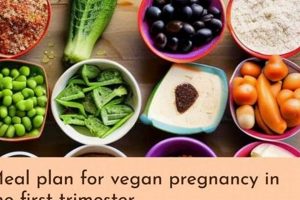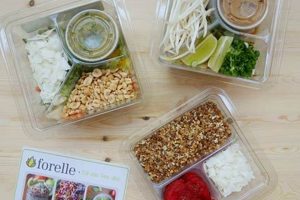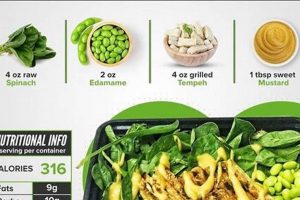Culinary preparations aligning with both raw foodism and veganism exclude all animal products and are not heated above a specific temperature, typically around 104-118F (40-48C). Examples include dishes composed of sprouted seeds, nuts, vegetables, fruits, and plant-based oils, carefully prepared to retain enzymatic activity and nutritional integrity. The objective is to offer sustenance in its least processed state.
The appeal of such culinary choices stems from perceived health advantages, ethical considerations surrounding animal welfare, and environmental concerns relating to conventional agriculture. Historically, the adoption of these dietary principles has been associated with movements advocating for natural living and sustainable practices. Proponents often emphasize the high nutrient density and digestibility of unprocessed plant matter.
The subsequent discussion will delve into specific aspects of constructing satisfying and nutritionally complete culinary options following these principles. Attention will be given to techniques, ingredient selection, and potential challenges in creating diverse and appealing plates, considering both taste and nutritional adequacy.
Constructing Satisfying Raw Vegan Evening Meals
Achieving culinary balance and nutritional completeness in raw vegan evening meals requires careful planning and thoughtful ingredient selection. The following guidelines offer practical strategies for optimizing both flavor and nutritional value.
Tip 1: Prioritize Nutrient-Dense Vegetables: Base meals on dark leafy greens, cruciferous vegetables, and colorful root vegetables. These provide essential vitamins, minerals, and fiber. For instance, a salad featuring kale, broccoli sprouts, shredded carrots, and beets delivers a broad spectrum of micronutrients.
Tip 2: Incorporate Healthy Fats: Nuts, seeds, avocados, and olives are crucial sources of essential fatty acids. Utilize these ingredients strategically; for example, a cashew-based cream sauce over zucchini noodles provides richness and satiety.
Tip 3: Emphasize Sprouted and Fermented Foods: Sprouting increases nutrient bioavailability, while fermentation enhances digestibility and introduces beneficial probiotics. Consider adding sprouted lentils to salads or incorporating sauerkraut made from raw cabbage.
Tip 4: Utilize Culinary Techniques for Texture and Flavor: Employ techniques like marinating, dehydrating, and blending to enhance the palatability of raw ingredients. Marinating vegetables in citrus juice and herbs can soften their texture and improve flavor profiles.
Tip 5: Season Generously with Herbs and Spices: Herbs and spices add depth of flavor and potential health benefits. Use a variety of seasonings, such as turmeric, ginger, garlic, and chili peppers, to elevate the taste of raw vegan dishes.
Tip 6: Consider Blended Soups and Smoothies: Blended preparations offer a convenient way to consume a concentrated dose of nutrients. A creamy soup made from avocado, cucumber, and herbs provides hydration and essential fats.
Tip 7: Explore Raw Vegan “Cheeses” and Desserts: Cashews, macadamia nuts, and other ingredients can be used to create convincing cheese alternatives and desserts. A cashew-based cheesecake can offer a satisfying end to the evening meal.
By integrating these strategies, one can create raw vegan evening meals that are both nutritious and enjoyable, supporting overall health and well-being. Careful attention to ingredient selection and preparation methods is paramount to achieving optimal results.
The subsequent section will address potential challenges and considerations associated with maintaining a long-term raw vegan lifestyle, including nutrient deficiencies and social aspects.
1. Enzyme Preservation
Enzyme preservation stands as a central tenet in the preparation and consumption of raw vegan dinner meals. The rationale rests on the understanding that enzymes, biological catalysts, play a crucial role in facilitating digestion and nutrient absorption. Raw food advocates believe that heat-processing denatures these enzymes, reducing the body’s capacity to effectively utilize nutrients.
- Maintaining Digestive Efficiency
Raw vegan diets aim to supply exogenous enzymes through uncooked foods, potentially reducing the metabolic burden on the body’s own enzymatic resources. For instance, including sprouted seeds or fermented vegetables in a dinner meal introduces enzymes like amylase and protease, which aid in the breakdown of carbohydrates and proteins respectively. This is postulated to improve digestive efficiency and reduce the incidence of digestive discomfort.
- Optimizing Nutrient Bioavailability
Enzymes facilitate the liberation of nutrients from complex food matrices. Phytates, naturally occurring compounds in grains and legumes, can bind to minerals and hinder their absorption. Sprouting, a common practice in raw vegan preparations, activates phytase, an enzyme that degrades phytates, thereby enhancing mineral bioavailability. A raw vegan dinner salad with sprouted lentils and almonds exemplifies this principle.
- Minimizing Metabolic Stress
Proponents argue that consuming enzyme-rich foods lessens the body’s need to produce digestive enzymes, freeing up metabolic energy for other essential functions. This concept, known as the “enzyme potential” theory, suggests that a diet rich in raw foods supports overall vitality. A raw vegan dinner consisting of blended green soup and a small portion of nut-based pate is proposed to exemplify this principle.
- Potential Limitations and Considerations
It is crucial to acknowledge the scientific debate surrounding the extent to which dietary enzymes survive gastric conditions and contribute to digestion. While some studies suggest that certain enzymes retain activity in the digestive tract, further research is warranted. Moreover, individuals with specific digestive disorders may require individualized dietary strategies beyond the scope of raw vegan principles.
The focus on enzyme preservation in raw vegan dinner meals underscores the intent to optimize digestive processes and nutrient assimilation. While the precise mechanisms and magnitude of benefit remain subject to ongoing scientific investigation, this principle forms a foundational element of the raw vegan philosophy. The selection of ingredients and preparation methods are consciously geared towards safeguarding enzymatic activity, reflecting a holistic approach to nutrition.
2. Nutrient Density
Nutrient density, the concentration of micronutrients relative to caloric content, assumes heightened importance within the framework of raw vegan dinner meals. The absence of animal products and reliance on uncooked plant-based foods necessitates a strategic approach to ensure adequate intake of essential vitamins, minerals, and phytonutrients.
- Vitamin B12 Acquisition
Vitamin B12, typically obtained from animal sources, poses a significant challenge for adherents of raw vegan diets. While some plant-based foods may contain B12 analogs, their bioavailability is often limited. Strategies for addressing this deficiency include consuming B12-fortified plant-based milks or nutritional yeast, or opting for B12 supplementation, guided by regular blood testing to monitor levels. Neglecting B12 intake can lead to neurological complications and anemia.
- Iron Bioavailability Enhancement
Plant-based iron, primarily in the non-heme form, is less readily absorbed than heme iron from animal products. Enhancing iron bioavailability requires combining iron-rich foods, such as dark leafy greens and legumes, with vitamin C-rich sources like citrus fruits or bell peppers. Soaking or sprouting legumes can also reduce phytates, compounds that inhibit iron absorption. A raw vegan dinner meal incorporating spinach salad with orange segments and sprouted chickpeas exemplifies this approach.
- Omega-3 Fatty Acid Sourcing
Obtaining adequate omega-3 fatty acids, particularly EPA and DHA, primarily found in fatty fish, demands careful planning in raw vegan diets. Alpha-linolenic acid (ALA), a precursor to EPA and DHA, is present in flaxseeds, chia seeds, and walnuts. However, the conversion of ALA to EPA and DHA is often inefficient. Incorporating these sources regularly and potentially supplementing with algae-derived EPA/DHA can help address this gap. A flaxseed oil-based dressing on a raw vegetable salad can contribute to omega-3 intake.
- Calcium and Vitamin D Sufficiency
Ensuring adequate calcium and vitamin D intake requires deliberate food choices and potential supplementation. Calcium-rich foods include dark leafy greens like kale and collard greens, as well as calcium-set tofu. Vitamin D synthesis depends on sunlight exposure, which may be limited depending on geographic location and lifestyle. Fortified plant-based milks or vitamin D supplementation may be necessary to maintain optimal vitamin D levels, particularly during winter months. A raw vegan smoothie with kale, almond milk, and a vitamin D supplement can address these nutritional needs.
The concept of nutrient density serves as a guiding principle in the creation of raw vegan dinner meals. By strategically combining nutrient-rich ingredients and addressing potential deficiencies through targeted supplementation, it is possible to achieve nutritional adequacy. The emphasis on whole, unprocessed plant foods aligns with principles of optimal health, but requires informed decision-making to ensure complete nutritional needs are met.
3. Ingredient Freshness
Ingredient freshness occupies a pivotal position within the domain of raw vegan culinary practices. The essence of raw veganism lies in consuming foods in their unheated, unprocessed state, thus amplifying the significance of the inherent quality and vitality of the ingredients utilized. The following points articulate the critical facets of ingredient freshness within this dietary context.
- Peak Nutritional Value
Freshly harvested produce, consumed shortly after harvesting, retains its maximum complement of vitamins, minerals, enzymes, and antioxidants. The degradation of these nutrients accelerates over time, particularly when exposed to light, air, and temperature fluctuations. Utilizing just-picked fruits and vegetables in raw vegan dinner meals ensures that the intended nutritional profile is fully realized, supporting overall health and well-being. For example, a salad composed of greens harvested the same day will offer a higher concentration of vitamin C and folate compared to greens stored for several days.
- Enhanced Flavor Profiles
Fresh ingredients possess more vibrant and nuanced flavors than their aged counterparts. Volatile aromatic compounds, responsible for characteristic tastes and aromas, diminish with prolonged storage. Incorporating recently harvested herbs, spices, and vegetables into raw vegan preparations elevates the sensory experience, contributing to heightened palatability and satisfaction. The taste of a freshly made raw salsa with just-picked tomatoes and cilantro will be markedly superior to one made with older, less vibrant ingredients.
- Reduced Risk of Spoilage and Pathogen Growth
Fresh ingredients exhibit a lower propensity for spoilage and harbor fewer microorganisms than older items. Raw vegan cuisine, by its nature, avoids heat processing, which typically serves as a means of eliminating pathogens. Therefore, prioritizing fresh, unblemished produce minimizes the risk of foodborne illness and ensures food safety. Thoroughly inspecting and washing all produce, especially leafy greens and sprouts, is crucial in mitigating potential contamination. A raw vegan dinner utilizing impeccably fresh sprouts will inherently present a lower risk compared to using sprouts nearing their expiration date.
- Optimized Textural Integrity
Fresh produce typically displays superior textural attributes compared to produce that has undergone prolonged storage. Crisp vegetables, firm fruits, and plump herbs contribute to a more appealing and satisfying culinary experience. The degradation of cell walls and loss of moisture during storage can result in wilted, softened, or otherwise undesirable textures. A raw vegan wrap featuring crisp romaine lettuce and juicy, freshly sliced cucumbers offers a more pleasant textural contrast than one made with limp, dehydrated vegetables.
In summation, ingredient freshness exerts a profound influence on the nutritional value, flavor, safety, and textural qualities of raw vegan dinner meals. The practice of prioritizing freshly sourced, high-quality ingredients represents a cornerstone of this dietary philosophy, contributing to both the enjoyment and the health benefits derived from this culinary approach. The principles outlined highlight the need to choose your ingredients well.
4. Flavor Combinations
Within the realm of raw vegan dinner meals, strategic flavor combinations are paramount to achieving both palatability and culinary satisfaction. The inherent limitations of raw ingredients, devoid of the transformative effects of heat, necessitate a heightened understanding of flavor interactions to create appealing and balanced dishes.
- Sweet and Savory Interplay
The juxtaposition of sweet and savory flavors is a critical technique in raw vegan cuisine. The natural sweetness of fruits, such as dates or berries, can be effectively paired with the umami notes of vegetables, herbs, or fermented ingredients. Examples include a salad of massaged kale with apple slices and toasted pumpkin seeds, or a raw nori wrap filled with shredded vegetables and a date-tahini dressing. This balance prevents flavor monotony and enhances overall enjoyment.
- Acidic Brightness and Richness
The incorporation of acidic elements, such as citrus juices, vinegars, or fermented beverages like kombucha, provides a counterpoint to the richness of nuts, seeds, and avocados, which often serve as primary sources of healthy fats in raw vegan meals. An example would be a creamy avocado soup enlivened with a squeeze of lime juice and a sprinkle of cilantro. This contrast cuts through the richness and prevents the dish from feeling heavy or cloying.
- Spice Integration and Aromatic Complexity
Spices and herbs are essential tools for adding depth and complexity to raw vegan preparations. The careful selection and blending of spices can transform otherwise bland ingredients into flavorful and aromatic dishes. A raw vegan curry, for instance, might incorporate ginger, turmeric, coriander, and chili powder to mimic the flavors of traditional cooked curries. Understanding the interactions between different spices and herbs is crucial for achieving desired flavor profiles.
- Textural Harmony and Flavor Perception
The interplay of textures significantly influences the perception of flavors in raw vegan cuisine. The combination of crunchy, creamy, and chewy elements enhances the sensory experience and contributes to a more satisfying meal. A raw vegan taco, for example, might include a crispy dehydrated vegetable “shell,” a creamy cashew-based “cheese,” and a chewy filling of marinated mushrooms and sprouts. This textural diversity amplifies the flavors and prevents sensory adaptation.
The successful application of these flavor combination principles is essential for creating palatable and nutritionally complete raw vegan dinner meals. By carefully considering the interactions between sweet, savory, acidic, and spicy elements, as well as the influence of texture, one can elevate raw vegan cuisine beyond simple ingredient combinations and achieve sophisticated and satisfying culinary results. Careful balance is required to ensure the culinary success of plates.
5. Textural Variety
The inclusion of diverse textures is not merely an aesthetic consideration; it significantly impacts the overall enjoyment and satisfaction derived from plates following raw vegan principles. The absence of cooking, which alters textures significantly, necessitates a strategic approach to create dishes that engage the palate and prevent monotony. Achieving plates with pleasing textures is as important as its flavors.
- Crispness from Fresh Vegetables
Crispness, often associated with fresh vegetables such as romaine lettuce, celery, and bell peppers, provides a refreshing contrast to softer elements. The mechanical action of biting into crisp vegetables stimulates saliva production and enhances the overall sensory experience. Raw vegan salads and wraps frequently rely on crisp vegetables as a foundational textural component. The presence of adequate texture is appealing in any meal setting.
- Creaminess from Avocados and Nut-Based Sauces
Creaminess, derived from ingredients like avocados, nut-based sauces, and blended fruits, offers a smooth, luxurious mouthfeel that contrasts effectively with crisper or chewier elements. Creaminess adds richness and satiety to raw vegan preparations, contributing to a more fulfilling meal. Examples include avocado-based soups, cashew “cheese” sauces, and blended fruit smoothies.
- Chewiness from Dried Fruits and Marinated Vegetables
Chewiness, imparted by ingredients such as dried fruits, marinated vegetables, and certain types of mushrooms, provides a more substantial textural element that requires sustained mastication. This prolonged chewing process can promote satiety and enhance the perception of flavor. Raw vegan meals often incorporate chewy elements to add depth and complexity to the textural profile, such as sun-dried tomatoes, marinated kelp noodles, or dehydrated fruit leathers.
- Crunchiness from Nuts, Seeds, and Sprouts
Crunchiness, obtained from nuts, seeds, and sprouts, introduces a contrasting texture that stimulates the palate and provides a satisfying oral sensation. Crunchy elements add a dimension of interest to raw vegan preparations and can also contribute to nutritional value. Examples include toasted pumpkin seeds sprinkled on a salad, chopped walnuts in a raw vegan stuffing, or sprouted lentils mixed into a vegetable medley.
The strategic integration of these textural elements is crucial for creating compelling raw vegan plates. By consciously incorporating crisp, creamy, chewy, and crunchy components, chefs and home cooks can elevate the dining experience and ensure that these meals are not only nutritious but also enjoyable and satisfying. Ensuring an interesting experience is important for people who follow plates under these principles.
6. Digestive Ease
Consumption of raw vegan dinner meals is often associated with improved digestive ease, stemming from several factors inherent in the diet’s composition. The high fiber content of uncooked fruits, vegetables, nuts, and seeds promotes regularity and facilitates the passage of waste through the digestive tract. Furthermore, the presence of naturally occurring enzymes in raw foods is believed to aid in the breakdown of nutrients, reducing the metabolic burden on the bodys digestive system. An example is a raw salad with a high water content, which can hydrate the digestive system and ease bowel movements.
The absence of processed ingredients, artificial additives, and refined sugars, common in conventional diets, further contributes to enhanced digestive comfort. These substances can often irritate the gut lining, disrupt the balance of gut microbiota, and trigger inflammatory responses. Raw vegan diets, in contrast, typically emphasize whole, unprocessed foods, which are less likely to cause digestive distress in many individuals. For instance, a raw vegan zucchini pasta with pesto, being free of gluten and dairy, can be a suitable option for individuals with sensitivities to these components. Additionally, the consumption of sprouted and fermented foods, such as sauerkraut or kimchi made from raw vegetables, introduces beneficial probiotics that support a healthy gut microbiome, improving digestion and nutrient absorption.
While digestive ease is frequently cited as a benefit of this diet, it is crucial to note that individual responses may vary. Some individuals may initially experience digestive discomfort when transitioning to a raw vegan diet due to the increased fiber intake. Careful planning, gradual dietary changes, and adequate hydration are essential for mitigating these potential challenges. In conclusion, the emphasis on whole, unprocessed foods, high fiber content, and presence of enzymes and probiotics collectively contribute to the perception of improved digestive ease associated with raw vegan plates. Further clinical research is necessary to fully elucidate the impact of this dietary approach on digestive health across diverse populations.
Frequently Asked Questions Regarding Raw Vegan Dinner Meals
The following questions and answers address common inquiries and misconceptions concerning the composition, nutritional adequacy, and practical implementation of raw vegan dinner meals. These responses aim to provide clarity and guidance for individuals seeking to understand and adopt this dietary approach.
Question 1: What constitutes a “raw vegan dinner meal?”
A raw vegan dinner meal consists exclusively of plant-based ingredients that have not been heated above a specified temperature threshold, typically between 104F (40C) and 118F (48C). This excludes all animal products and processed foods, focusing instead on fresh fruits, vegetables, nuts, seeds, sprouted grains, and legumes prepared using methods such as blending, juicing, dehydrating, or fermenting.
Question 2: Are raw vegan dinner meals nutritionally complete?
Achieving nutritional completeness on a raw vegan diet requires careful planning and attention to specific nutrients that may be limited in plant-based sources. Vitamin B12, iron, calcium, vitamin D, and omega-3 fatty acids warrant particular consideration, often necessitating supplementation or strategic food combinations to ensure adequate intake. Consultation with a registered dietitian or healthcare professional is recommended.
Question 3: What are some common challenges encountered when preparing raw vegan dinner meals?
Challenges may include sourcing high-quality, fresh ingredients, managing food preparation time, maintaining textural variety, and addressing potential digestive discomfort associated with the increased fiber intake. Adhering to the temperature restrictions may also limit culinary options and require specialized equipment, such as dehydrators or high-speed blenders.
Question 4: How can flavor be enhanced in raw vegan dinner meals without the use of heat?
Flavor enhancement relies on strategic combinations of herbs, spices, citrus juices, vinegars, and natural sweeteners such as dates or maple syrup. Marinating vegetables, utilizing fermentation techniques, and employing high-quality oils can also contribute to complex and appealing flavor profiles. Experimentation with different textures and flavor pairings is essential.
Question 5: Is a raw vegan diet suitable for all individuals?
A raw vegan diet may not be appropriate for all individuals, particularly those with specific medical conditions, nutrient deficiencies, or increased nutritional needs, such as pregnant or breastfeeding women. It is crucial to consult with a healthcare professional to assess individual suitability and address any potential risks or contraindications.
Question 6: What are the potential benefits associated with raw vegan dinner meals?
Proponents of raw vegan diets often cite potential benefits such as increased energy levels, improved digestion, weight management, and reduced risk of chronic diseases. However, these claims require further scientific investigation and should be considered in conjunction with the potential challenges and nutritional considerations outlined above.
In summary, raw vegan dinner meals represent a specific dietary approach with distinct characteristics and considerations. While potential benefits exist, careful planning, attention to nutritional adequacy, and individual suitability assessment are crucial for successful implementation.
The subsequent discussion will delve into practical tips and recipes for creating satisfying and nutritionally balanced raw vegan dinner meal options.
Raw Vegan Dinner Meals
The preceding exploration has illuminated the multifaceted nature of raw vegan dinner meals, encompassing their definition, nutritional considerations, culinary techniques, and potential challenges. Attention has been given to the importance of ingredient freshness, flavor combinations, textural variety, and digestive ease in crafting satisfying and nutritionally adequate plates. The discussion underscored the need for careful planning and informed decision-making to address potential nutrient deficiencies and ensure long-term sustainability of this dietary approach.
The adoption of raw vegan dinner meals, while potentially offering certain advantages, necessitates a comprehensive understanding of its implications and a commitment to meeting nutritional needs through strategic food choices and, when necessary, appropriate supplementation. Individuals considering this dietary path are encouraged to seek guidance from qualified healthcare professionals and registered dietitians to optimize health outcomes and mitigate potential risks. The information presented serves as a foundation for informed decision-making, promoting responsible and sustainable dietary practices.







